 THIS PROPERTY IS NOW SOLD
THIS PROPERTY IS NOW SOLDMegaw House, Vernon
 THIS PROPERTY IS NOW SOLD
THIS PROPERTY IS NOW SOLDReport a Violation – Do you know of cases where fish habitat has been illegally destroyed and nothing has been done about it? Fill in our new online form and submit photos. Your report will be reviewed by a scientific expert. In the cases where serious violations are not acted upon, we will consider the following: pursuing media campaigns to draw attention to the habitat destruction, and mounting private prosecutions against the violators.
A re-release of a book by BC pioneer, Chris Czajkowski. Chris is a botanist who operates a fly-in wilderness retreat where she built her own cabins single-handedly.
 "The long-awaited reprinting of Diary of a Wilderness Dweller is finally taking place. This book was a national best-seller when it was first issued, but the publisher of the time phased out his adult books.
"The long-awaited reprinting of Diary of a Wilderness Dweller is finally taking place. This book was a national best-seller when it was first issued, but the publisher of the time phased out his adult books.
"The book details my experiences while starting the cabins at Nuk Tessli. The narrative covers a period of three years, starting in 1988 with the first fateful chainsaw cut that changed forever this remote, high-altitude lake in British Columbia's Coast Range, and ending with the completion of two cabins and the arrival of my first paying guests. I worked alone all that time, falling trees and hauling them inch by inch with a come-along, and then raising them with various scaffolds and a block and tackle. I had many encounters with nature, with both wildlife and whatever the elements could throw at me, especially on my overnight hikes to and from the road."
- Chris Czajkowski
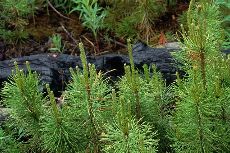
[Last in a three-part series]
It might not be so bad if the only problem we had to worry about in BC's forests these days was the armies of mountain pine beetles that have killed millions of trees over an area roughly the size of Ireland.
One of the joys of living on the far-flung western edge of the Chilcotin Cariboo is the constant stream of reminders the changing seasons bring - reminders that we are just one part of a large, complex system that is constantly evolving, life and death intimately entwined on the miracle of Earth.
Driven by sheer force of the sun, spring breaks free from winter's icy embrace, melting snows driving the boisterous river to burst its frozen bonds. Warm sweet winds fill the air with fir perfume and redwings return to beckon the lazy hazy days of summer with their quicksilver song.
Now it is fall time. The leaves along the highway are a brilliant yellow, backlit by the morning sun, exploding into your eyes like mercury lights in a stage production.
Alas, all is not beauty and warm sensuality when the harbingers of the changing seasons come calling.
Like the rest of us, the Chilcotin critters need a place to spend the winter. And what better place than a dry, well stocked nest that is also centrally heated? Maybe it is a roof ever so humble or a wall with its nice pink fluffy quilts or, even better, a pantry full of all those great goodies. Nuts, seeds, flour, raisins, dates, a cornucopia that never ends.
All these denizens have to do is to figure out a way to get inside these great winter digs.
Mice are the sneaky ones. They can crawl through the tiniest holes, wriggle into the smallest crevices. There is even one species of Chilcotin mouse that has a communicator for asking the mother ship to "Beam me in, Scotty".
Packrats are not nearly so subtle. They are a straight ahead bunch. Kick the door in if they can. Noisy, bump thump all night long, these masters of demolition never give up.
The have been known to chew through one inch fir roofing boards, through 90 pound roll roofing, make tunnels straight up through the wall to the upper plate, find a way into the attic and then to chew down into the room below.
Packrats have an amazing understanding of spatial dimensions. How else can you explain one now famous packrat that chewed into the gable end of the house, went across the roof up and over the rafters, went down the inside the wall on the opposite gable, under the house, up into the floor, then over six feet to then chew up through the floor and, Voila!, hit the middle of the pantry? NASA has nothing on a Chilcotin packrat.
Aside from their unique perfume and their destructive tendencies, packrats are very good looking, cream and buff coloured with sharp eyes and well formed muffs for tails. They are very polite, making sure that they trade for everything they take. Spoons for eyeglasses or hay for raisins, they are very fastidious about this, much more so than most humans are.
In spite of their politeness in matters of trading, the pack rat must go. So, in the end, the packrat meets its nemesis, the Chilcotin resident. Trap in hand, a trusty length of stove pipe over his shoulder and peanut butter/raisin bait in his pocket the scene is set. Not to be outdone, Packrat steals the bait and begins its usual three a.m. shopping spree in the pantry.
Time to bring in reinforcement known as the Chilcotin feline, best little killer in the west. A few minutes in the pantry, scrabble! squeal! and the rat is caught. Not dead, caught. As everyone knows, the Chilcotin feline doesn't kill, not right away. So with thick leather gloves complete with gauntlets, (the Chilcotin resident has done this before) the game of "catch the cat before the cat drops the packrat so it can run under the piano" is underway.
This time it is resident 1, packrat 0. When the cat drops the rat, the resident quickly swoops up the dazed rat, takes it outside and uses a fire brick to crush its skull on the porch railing. Nasty, brutish and short, to quote an infamous judge.
And so it goes, the changing seasons shared the world over by mice, packrats and men.
© Dave Neads
Geographically, we certainly don't live in the Pacific Northwest, which, if it describes anywhere, is surely somewhere near the coast of Russia, say on the shores of Kamchatka. And we don't even live in the Northwest of this continent. Look at a map; we are only about half way up.
Now, while it is the case that Washington State is in the northwest of the (contiguous) United States, that is hardly relevant to us. We live in the Southwest! (Please don't make me explain of what).
Do we embrace such a term because the centre of our universe is south of the border? Hardly (well, at least not for those of us who don't export pot). Or is it that we meekly follow any linguistic bellwether which wanders across our field? Now, that is a possibility.
Hear him out and see what you think.
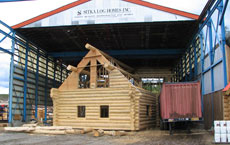
British Columbia will be represented at the 2006 Turin Olympic Games by a log cabin. I suppose we are not sending an igloo because it would melt?
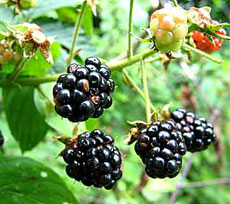 Wish you were here
Wish you were here To be honest, we thought we’d cut ourselves some slack. We were going to northern British Columbia, for god’s sake. We could hardly be expected to stick to some monkish vow to eat only those foods produced in a hundred-mile radius. Environmental sustainability would, like us, be taking a summer holiday.
Last week in British Columbia, in the biggest foreign takeover since the 2002 buy-up by South Carolina's Duke Energy of Westcoast Transmission, Texas-based Kinder Morgan picked up Terasen -- B.C. Gas before it was privatized -- the province's largest natural gas distribution company and the biggest private sector provider of water services in Western Canada.Read the rest
Many are warning about the need to plan for 10-15 years from now when the currently busy mills begin to close because there is not that much pine around any more. One place you don't hear much of this line of thinking is in government. I guess they only have to think four years ahead.
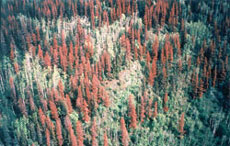
Timelines in forestry are long, far longer than election cycles, which is why governments of all political stripes are often reluctant to invest in reforestation.
There's a danger in such thinking, however, because it causes us to lose sight of where our forestry dollars end up. In British Columbia, forestry related activities fund many of our public services. For that reason, nurturing our publicly owned forests makes a lot of sense. By investing in them today, we set the table for a more secure tomorrow.
Unfortunately, such investments are not being made. And continued failure to do so ensures great hardship for Interior communities in the years ahead.
ALIENS IN THE CHILCOTIN
They go on for miles and miles. Evenly spaced alien footprints on an ancient land. Posts neat and straight, all the same height, the spoor of factory fences is appearing everywhere in the Chilcotin Cariboo.
The most recent manifestation of this otherworldly phenomenon is along Highway 20, just up on the flats west of Barr Hill. Beneath the new telephone poles, running in a trench scraped by a cat, the barbed wire fence glistens in the sun, its razor edges there for all to see.
Well, not for all to see. Further west, just outside of Nimpo Lake there is another factory fence. It was built in the mid-nineties, just about a decade ago. The wire is sagging, the poles are leaning, and there are sections where animals have become tangled and torn the wire free of the poles.
In one ten mile stretch you will see dozens and dozens of places where once red flagging tape still exists, wrapped along the top wire. These were put there by Ministry of Environment people when we still had Ministry of Environment people who were employed and actually went out on the land.
The purpose of the ribbons? They marked the top wires that were covered in moose hair or bits of hide where the animal had tried to jump the fence, but for whatever reason, had miscalculated or perhaps been caught in the snow - but the fact is, some of the critter was left behind on that barbed wire.
These ribbons give mute testimony to the failure of barbed wire to be friendly to wildlife.
Yet, here we go again, building miles and miles of barbed wire fence on costly green poles along Highway 20. Why?
Well, we are told, it is cheap to build, easy to maintain and lasts a long time. Look at those nice pretty green posts, full of those nice chemicals, look at the miles of shiny new wire, its cutting edges sparkling in the sunlight. What could be better than that?
Logs, that's what. Traditional log fencing. We have more dead trees than we can handle in the Chilcotin. We have people who need work, including horse loggers and others who are willing to handle fencing contracts. The moose, deer, horses and other animals who get hung up on, cut by and clotheslined with barb wire sure don't think it is a good idea either, all those miles and miles of barb wire on a once safe range.
As to the cost, maintenance, and longevity issues, the fence further west gives lie to that argument. It is a perfect test case. On the west side of the highway stands a log fence and on the east side stands (sort of) a factory fence. Both were built at about the same time.
As you drive along switching your gaze from one to the other, it soon becomes clear that the log fence is actually in better shape than the factory fence. It still stands proud and strong, a testament to the men who built it, to the men who were paid wages with which to buy groceries and feed their local families, using environmentally friendly local materials, which will last twenty to twenty five years before they need to be replaced, before they will become firewood or habitat for insects and other wildlife. And that fence doesn't skin or kill any horses or wildlife.
Contrast the factory fence, sagging and falling over, wire busted and tangled where it has maimed or maybe even killed horses and moose and deer.
When the full cost is considered, not just the narrow bottom line of the project, log fences are the big winners. We don't need factory fences made with chemicals and steel that were produced by processes located in factories thousands of miles away. These factories use non-renewable resources, belch greenhouse gasses into the air and make profit for corporations and their shareholders in distant lands.
We need fences that serve all, we need fences that are esthetically pleasing, environmentally sustainable, provide greater local employment, are wildlife friendly and which are, in the end, the best and cheapest option available. We need log fences, not alien factory monsters marching lockstep across the land.
Dave Neads
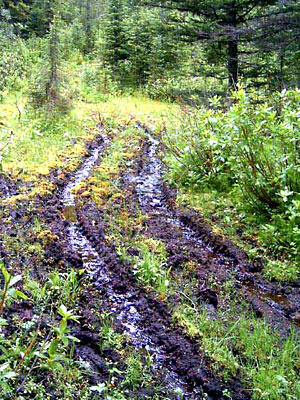
Mr. John Gibson, Fox News:
In reading your comments about Canada in your article in MacLeans Magazine I wondered how a newsperson with all of the resources you must have for in-depth research could have written such a shallow, cliché-ridden article.
I am a rural Canadian, living six hours drive from the nearest large city (Vancouver). I live in a community that depends on forestry, agriculture and tourism for its economic well being. That means that your comments on mad cow and softwood lumber bear some thought. As well your overall tone of sarcasm deserves a response.
First you must understand that every Canadian is always aware that we rarely appear on America's radar screen unless America sees a major advantage. Softwood lumber and agriculture are a case in point. When America wanted the North American Free Trade agreement it was fiercely negotiated on all sides but in the end was determined by the American negotiators. However, your lumber interests were not prepared to see softwood lumber part of an open free trade, hence the softwood lumber agreement. Once that agreement was up for renewal your industry and government deemed Canada an unfair competitor and heavy duties were placed on shipments to the USA. The only people who have really suffered is the American consumer. But, what really burns those of us who live in rural Canada is that, at every court challenge, America has lost and has simply refused to accept the rulings, even those where American members of the tribunal were in the majority.
When your government, after much careful investigation and with the full cooperation of Canada, decided to lift the ban on Canadian cattle you found a way through the courts to stop the lifting.
What we have learned from these particular actions is that there is no way of winning when you deal with America. The rule of law for you simply highlights the need to find or write a new law.
And dare I mention agricultural subsidies? Yesterday we bought apples in our local store that are a product of the USA. They were cheaper than Canadian apples simply because of your farm subsidies.
Your little excerpt from your book 'Hating America, the New World Sport' does not include any Canadians I know. None of us hates America. Most of us have friends and often relatives south of the 49th parallel. But we are a nation one-tenth your size in population (in fact the population of California is greater than Canada's). We are wary of you. Canada has only been invaded by a foreign power twice in our history, both times by the USA. We know that the minute you deem it in your national interest to need our water or oil that you can come and take it.
You see, as the 'New Roman Empire', we have to be wary and sometimes this may come across as being angry or jealous or any of the other adjectives you used. America has demonstrated many times in recent years that its interests supersede everything, including national sovereignty.
So pull in your horns a bit. We don't hate you; we aren't jealous; we're careful. To misquote one of our politicians, sleeping next to an elephant makes one careful.
Sincerely,
Jack Witty
108 Mile Ranch, BC
The Tyee: What a Black Beetle Can Teach Us
A dead sea of red. Lorraine Maclauchlan photo, B.C. Ministry of Forests
Mountain pine beetle–infested timber is helping B.C. boom. Will we learn the bug plague's lessons before the bust?
By Jared Ferrie, July 4, 2005
As mountain pine beetles continue to munch their way through B.C.'s forests, logging companies are ramping up operations in order to harvest the millions of hectares of dead trees left in their wake.
 Word has it that this is the worst summer in a long time for mosquitoes. I guess I should say it's a very good year for mosquitoes and a bad year for humans and other warm-blooded mammals. It's also a good year for swallows and other flying insectivores, including dragonflies. "Dragonfly naiads consume mosquito larvae in the breeding waters, and adult dragonflies eat adult mosquitoes." (Wikipedia). Which brings me to the helpful part of this post:
Word has it that this is the worst summer in a long time for mosquitoes. I guess I should say it's a very good year for mosquitoes and a bad year for humans and other warm-blooded mammals. It's also a good year for swallows and other flying insectivores, including dragonflies. "Dragonfly naiads consume mosquito larvae in the breeding waters, and adult dragonflies eat adult mosquitoes." (Wikipedia). Which brings me to the helpful part of this post:
Mosquito Deterrents: This is the best information I could find. I certainly haven't tested all of these recommendations so use your own judgement and feel free to let me know directly, or as a comment below, what your experience or knowledge is.
NOTE: It is generally agreed that for most reliable protection, (e.g. where West Nile Fever is a risk) the best product is DEET. Note that DEET can damage synthetic fabrics and there are questions about its effect on the human body. The American Academy of Pediatrics recommends that repellents used on children contain no more than 10% DEET - and not at all on children under two months. Lotions can be applied more effectively than sprays. Don't use with sunscreen because DEET should not be re-applied. Wash off after use.
A. On/in your body:
B. In/around the home:
Science for Peace Bulletin
May 2005 - Volume 25, Issue 2
Terminators Galore!
Joe Cummins
The author is Professor Emeritus at the University of Western Ontario.In Canada, the Seed Sector Review advisory committee issued a report calling for changes to legislation to
(A) collect royalties on farm-saved seeds,
(B) compel farmers to buy officially certified seed, and
(C) terminate the right of farmers to sell common seed.The report was financed by the Agriculture Ministry at a cost of nearly a million dollars to the Canadian taxpayers but essentially rubber-stamped the demands of multinational agricultural corporations (1). The onerous licensing requirements of the biotechnology industry are to be extended to all seeds, imposing a form of serfdom on any remaining independent farmers. In the future it is likely that even home gardeners will face the loony corporate payments for those willing to spy on neighbors and report covert seed activity. We may be entering a time when the Royal Canadian Mounted Police are required to raid grow operations such as a row of radishes in a backyard garden.
See also:
The sounds of avalanches and of moose calling and feeding in the cool grey dawn, the soul-touching howl of a wolf pack, and the myriad tiny sounds of the wilderness have wakened me to greet the dawn from one end of the Muskwa-Kechika to the other.Read the author's review
........................... Photographer Wayne Sawchuk grew up in Chetwynd and worked as a logger before turning to the Northern Rockies as a guide and trapper where he fell in love with the beauty of the area. Sawchuk has been a full-time conservationist since 1993 and played an integral part in creating the Muskwa-Kechika Management Area, along with George Smith, National Conservation Director of the Canadian Parks and Wilderness Society.
 Today I learnt more about a creature that I think is a good candidate for the Interior BC animal: The Fisher.
Today I learnt more about a creature that I think is a good candidate for the Interior BC animal: The Fisher.Fisher have to work a lot harder to hunt and travel when snow is deep and soft. Fishers, when they travel in deep snow, use 54% more energy per day than on hard snow. This may be why there are few fishers in coastal BC where deep, wet snow is more common.After you've learned about the Fisher, take a look at the rest of the CCCS site. It's one of my big favourites.
A crannóg is a dwelling built on stilts over a bog or a wetland: found all over Ireland and Scotland, they housed animals and humans. The crannóg is a direct link both physically and philosophically to Brian MacIssac and Rebecca Kneen’s fabulous farmhouse micro-brewery. To say that Rebecca Kneen and Brian MacIsaac are purists is putting it mildly."What about the beer", you say? Read on.
The name of their farm, Left Field, speaks volumes. These folks care about both the environment and the quality of their extraordinary brews. Brian speaks and teaches Gaelic, and as an artist his intricate knot work decorates the buildings and his labels. Even the couple’s bodies sport his tattooed designs.
The Truth about a 'Strong Opposition'
by Rafe Mair
TheTyee.caForgive me if I go over a bit of old ground but it really is time we all understand what really happens in the Legislature and, more importantly, what does not. In interviewing two of the “star” Liberal candidates, Wally Oppal and Carole Taylor, I heard what I can only describe as breathtaking naiveté. They were going to raise the level of debate and bring fresh ideas to the House. They will do no such thing, of course.
We're different enough to learn a lot from each other.
In The Northwest: Canada, U.S. can learn from other's press freedomBy JOEL CONNELLY
SEATTLE POST-INTELLIGENCER COLUMNISTVICTORIA, B.C. -- Just as the majesty of 10,778-foot Mount Baker is best appreciated looking across the water from a B.C. ferry, a stay in Canada gives just enough distance for perspective on freedoms shared across the 49th parallel.
The bottom line is, land in the hands of a person rooted on the land, or a community, or even a company, is a thousand times better than land in the hands of footloose capital.In the West Kootenays, we're very different than the rest of B.C. We have, in the main, avoided the consolidation disease that has destroyed the market for wood and the affinity for the land that has occurred in almost every other Timber Supply Area in the province. In the '90s, we created more and different forms of tenure here than just about anybody else. Actually, I would like to see the forest industry operate like the dairy industry, where it is against the rules for a person who milks cows to also be the person who processes the milk. The vertical integration and monopoly systems -- that have destroyed so much of the creativity and enterprise in the forest industry -- is simply not allowed in B.C.'s agriculture sector.
- from an Interview with Corky Evans in The Tyee
For much of BC, Summer has become "the fire season". Two of our TV networks have been thinkng ahead and come up with programmes that look to be useful briefings for the coming summer. If, having seen one or other of them, you have any comments, drop by here and tell us.
1. Firesmart British Columbia - The Knowledge Network
Airing three times:
"The provincial government, a variety of experts, and BC communities work together to plan protection against the dangerous wildfires that sweep into communities and subdivisions."
2. Fighting Fire with Fire - CBC: The Nature of Things
Thursday May 26 7:00 pm
"Monster forest fires, big enough to be seen from space and hot enough to create their own weather, used to be a once-in-a-decade nightmare. But now, they’re an everyday summer reality across vast stretches of North America. Authorities in Canada and the United States are bracing for the 2005 fire season. They fear this will be the year of the inferno.."
In the end an overwhelming majority agreed that the electoral system should change, that the change should be to what they call BC-STV (basically Hare-Clark but with electorates of varying populations and numbers of MPs) and a referendum giving final choice to the voters. The whole process restores one’s faith in the wisdom of the population. In discussing their conclusions the assembly members get to the heart of what democracy should be about, and they weighed up which system will best provide this. What's more, they communicated their decision in clear and moving prose of the kind that is now an endangered species in Australian political discourse. It’s easy to get depressed about the state of politics in Australia and around the world, but the Citizens’ Assembly indicates a way out. Don’t leave it to a bunch of self-interested megalomaniacs. Don’t go for citizen’s initiated referenda – which only work if the population pays attention and sees through the expensive campaigns of special interest groups. Instead, take a random sample of ordinary people and give them access to everyone’s views, and the time for proper consideration.Full article